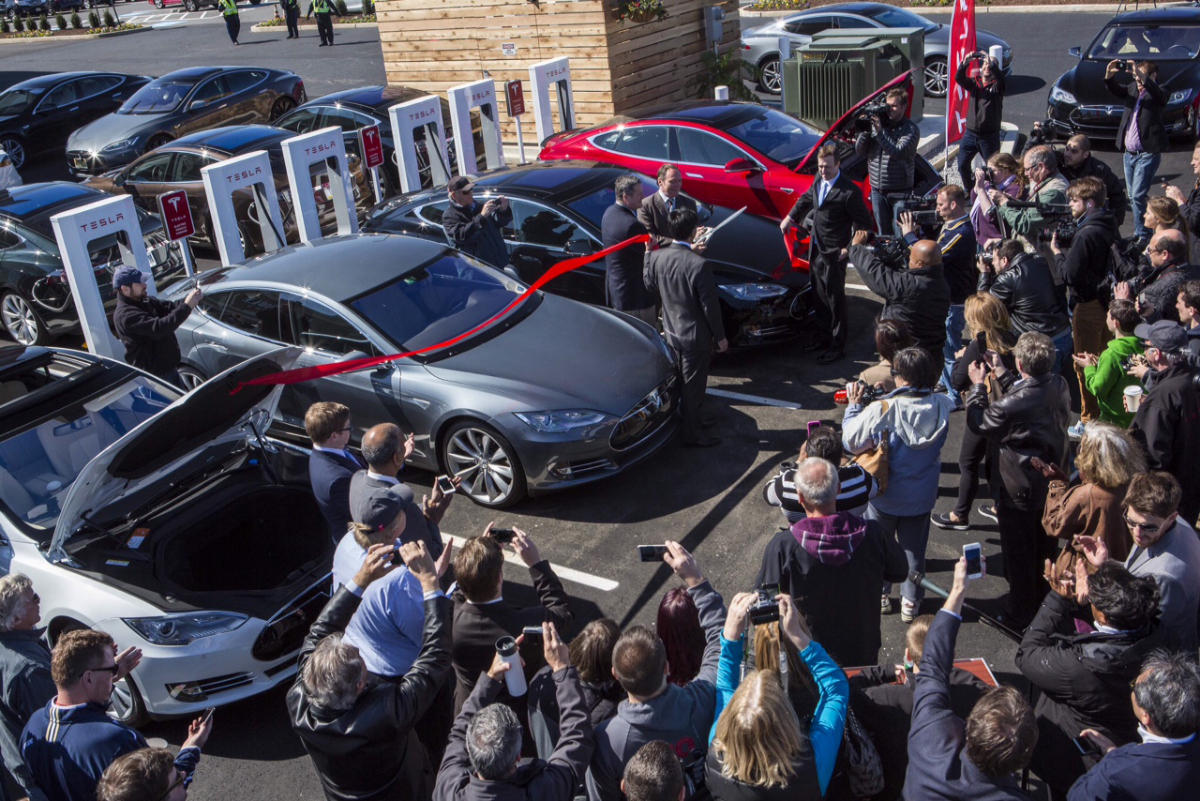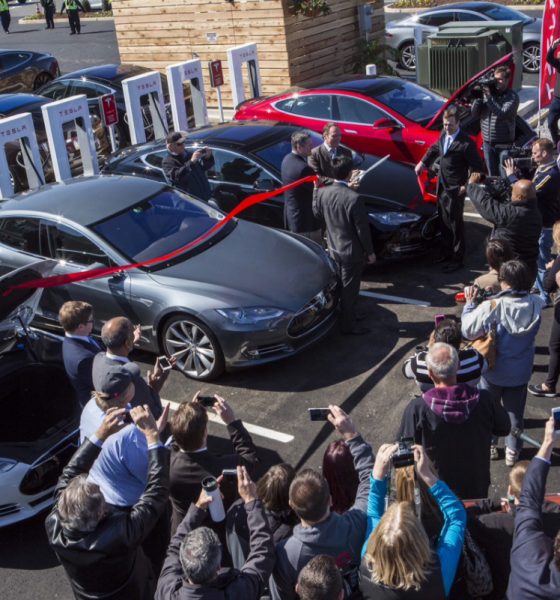Tesla’s unique business model allows them to sell vehicles directly to consumers through both retail locations and Tesla’s online design studio. Direct-to-consumer sales of its vehicles have led to some turbulence with existing car dealerships in many states, including Utah, Louisiana, Connecticut, Texas and Michigan. New Jersey allowed Tesla to open direct sales in the state in 2015, but with conditions. New Jersey’s legislation limited the number of direct-to-consumer dealerships per manufacturer to four stores and required at least one service center in the state. Tesla CEO Elon Musk once compared local car dealers to a mafia protection racket, stating in a Tesla blog post, “The rationale given for the regulation change that requires auto companies to sell through dealers is that it ensures ‘consumer protection’…Unless they are referring to the mafia version of ‘protection’, this is obviously untrue.”
Tesla recently launched a lawsuit to overturn a sales ban put into effect in Michigan in 2014 that prevents the Elon Musk-led electric carmaker from selling directly to consumers within the state. The greatest opposition against Tesla’s plea for direct sales in Michigan comes from both auto dealers and manufacturers, who argue that Tesla disrupts the traditional franchise dealership model.
Courtesy of Teslanomics.co
Ironically, Michigan and Texas which bans Tesla’s direct sales model have public pensions that are significant investors in the Silicon Valley company. However, that isn’t the only financial interest states have in Tesla. All states in the US rely heavily on sales tax to generate revenue. States without stores are forcing owners to purchase and service their vehicles out-of-state, missing out on sales tax in the process, a major revenue loss.
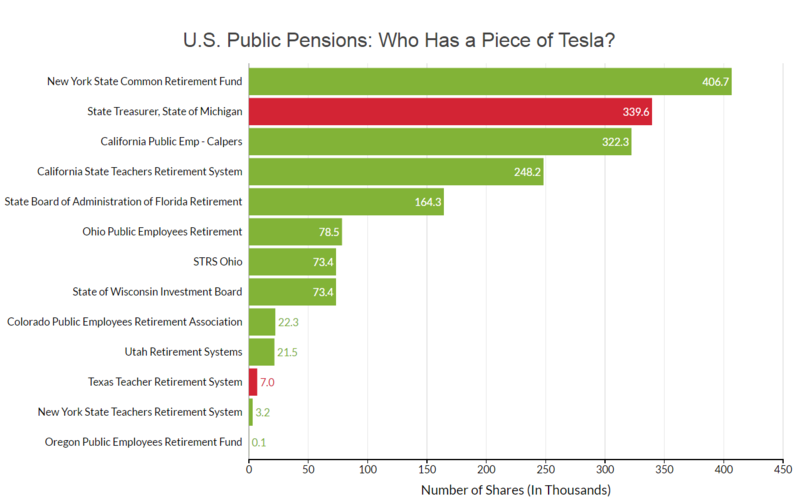
Source: Bloomberg, September 2016
Bill Wolters, of the Texas Automobile Dealers Association, is claiming that the introduction of Tesla into the Texas car market would “reduce competition”, and will incur costs for Texas. However, this argument assumes that dealers are creating added value for their consumers, and if that argument holds, then dealers should be able to keep customers in the market after Tesla enters. Additionally, Tesla is competing against other manufacturers and not franchises.
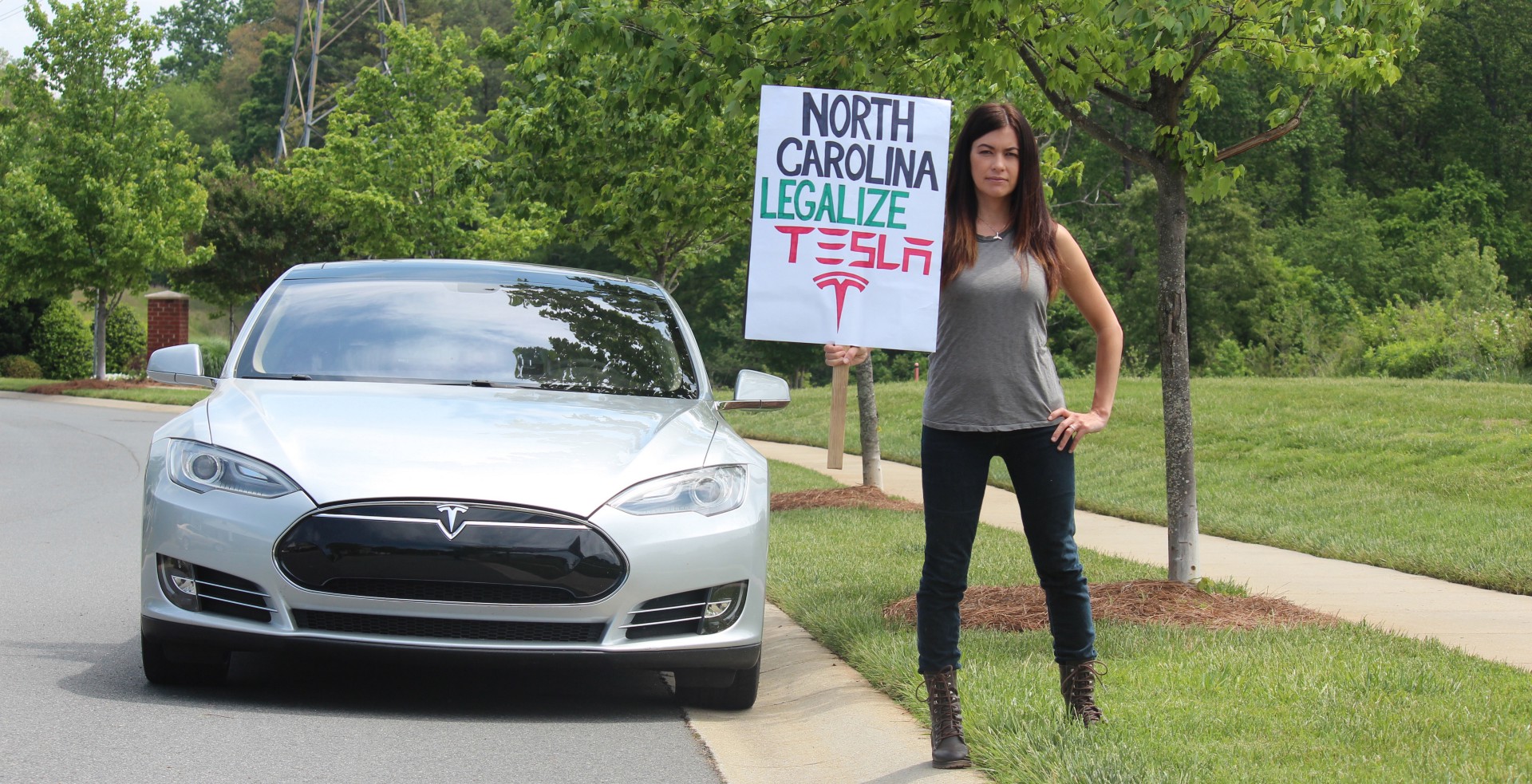
Racecar driver and environmental activist Leilani Munter protest’s North Carolina’s ban on Tesla’s direct sales model (Photo: Medium/Leilani Munter)
Out of a presumed 400,000 reservations for the Tesla Model 3, it is estimated that roughly half originate from the United States, according to the distribution of early Model 3 reservation data from Model3Tracker.info. Using a loosely estimated assumption of Tesla Model 3 reservations originating from banned states via Model3.ocasual.com, we get the following numbers: 1,250 in Louisiana, 2,980 in Connecticut, 3,076 in Utah, 15,670 in Texas, and 4,230 in Michigan.
The sales tax for Michigan is 6%, Louisiana is 9%, Connecticut is 6.35%, Utah is 4.7%, and Texas is 6.25%
This equates to a loss of $8,883,000 for Michigan, $3,937,500 for Louisiana, $34,278,125 for Texas, $6,623,050 for Connecticut, and $5,060,020 for Utah. That’s a total of $59,791,695 in loss revenue, which does not factor in current sales of Model S and Model X.
| States with Tesla Ban | Sales Tax | Estimated Tesla Model 3 Reservations | Projected state revenue loss (in dollars) |
| Louisiana | 9% | 1250 | $3,937,500 |
| Texas | 6.25% | 15670 | $34,278,125 |
| Michigan | 6% | 4230 | $8,883,000 |
| Connecticut | 6.35% | 2980 | $6,623,050 |
| Utah | 4.70% | 3076 | $5,060,020 |
Navigant Research believes that sales electric vehicles, including hybrid/plug-in hybrid, are set to comprise 9 percent of total vehicle sale by 2025. Currently, EVs make up 3% of total vehicle sales, but the number in 2016 saw a 36 percent increase in sales in the US alone. In 2016, 4,500 EVs were sold in Texas, 2,470 in Michigan, 270 in Louisiana, 1,452 in Connecticut, 1,132 in Utah, and 70 in West Virginia. Texas, Connecticut, and Michigan ranked among states with some of the highest EV sales. Of electric vehicles sold total in 2016, the Tesla Model S was the leading electric vehicle with ringing in at 29,156 vehicles. The Tesla Model S also outsold its entire class of vehicles, combined. Tesla is expecting high demand for Model 3, which will start at roughly half the cost of the Model S.
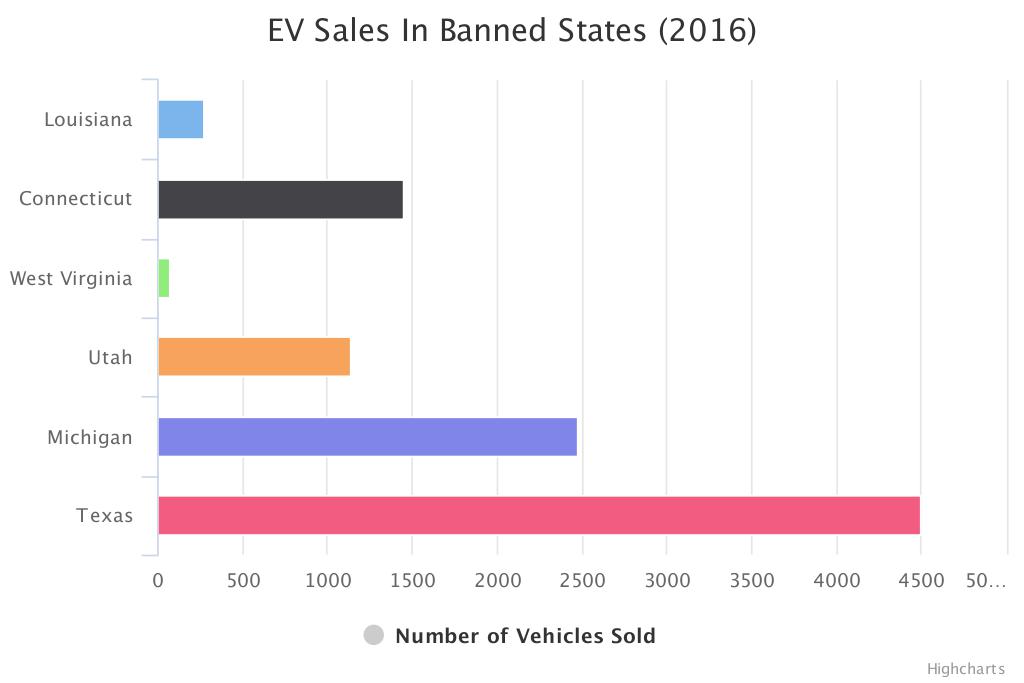
Source: Topspeed.com
There are currently 223,319 estimated Model 3 reservations in the United States, far greater than the sales of comparable vehicles. The BMW 3 and 4 series which sold around 106,000 vehicles in 2016 and the Mercedes C-Class sold around 77,000 vehicles in 2016. Tesla CEO Elon Musk is expecting to produce 500,000 vehicles in 2018 and tens of thousands this year (Tesla hasn’t released Model 3 production guidance for 2017). Musk’s expectations could make the Model 3 the highest selling vehicle in its class in both 2017 and 2018. The states that ban Tesla dealerships not only miss out on sales tax revenue from Tesla vehicles but in turn create an inconvenience for residents. By instating a direct sales ban on Tesla before the launch of Tesla Model 3, states will not only lose millions of dollars in sales revenue per year but also interfere with and disrupt free market competition and consumer activities.
Feature image courtesy of Delanman via Twitter.

Elon Musk
Elon Musk’s X will start using a Tesla-like software update strategy
The initiative seems designed to accelerate updates to the social media platform, while maintaining maximum transparency.

Elon Musk’s social media platform X will adopt a Tesla-esque approach to software updates for its algorithm.
The initiative seems designed to accelerate updates to the social media platform, while maintaining maximum transparency.
X’s updates to its updates
As per Musk in a post on X, the social media company will be making a new algorithm to determine what organic and advertising posts are recommended to users. These updates would then be repeated every four weeks.
“We will make the new 𝕏 algorithm, including all code used to determine what organic and advertising posts are recommended to users, open source in 7 days. This will be repeated every 4 weeks, with comprehensive developer notes, to help you understand what changed,” Musk wrote in his post.
The initiative somewhat mirrors Tesla’s over-the-air update model, where vehicle software is regularly refined and pushed to users with detailed release notes. This should allow users to better understand the details of X’s every update and foster a healthy feedback loop for the social media platform.
xAI and X
X, formerly Twitter, has been acquired by Elon Musk’s artificial intelligence startup, xAI last year. Since then, xAI has seen a rapid rise in valuation. Following the company’s the company’s upsized $20 billion Series E funding round, estimates now suggest that xAI is worth tens about $230 to $235 billion. That’s several times larger than Tesla when Elon Musk received his controversial 2018 CEO Performance Award.
As per xAI, the Series E funding round attracted a diverse group of investors, including Valor Equity Partners, Stepstone Group, Fidelity Management & Research Company, Qatar Investment Authority, MGX, and Baron Capital Group, among others. Strategic partners NVIDIA and Cisco Investments also continued support for building the world’s largest GPU clusters.
News
Tesla FSD Supervised wins MotorTrend’s Best Driver Assistance Award
The decision marks a notable reversal for the publication from prior years, with judges citing major real-world improvements that pushed Tesla’s latest FSD software ahead of every competing ADAS system.

Tesla’s Full Self-Driving (Supervised) system has been named the best driver-assistance technology on the market, earning top honors at the 2026 MotorTrend Best Tech Awards.
The decision marks a notable reversal for the publication from prior years, with judges citing major real-world improvements that pushed Tesla’s latest FSD software ahead of every competing ADAS system. And it wasn’t even close.
MotorTrend reverses course
MotorTrend awarded Tesla FSD (Supervised) its 2026 Best Tech Driver Assistance title after extensive testing of the latest v14 software. The publication acknowledged that it had previously criticized earlier versions of FSD for erratic behavior and near-miss incidents, ultimately favoring rivals such as GM’s Super Cruise in earlier evaluations.
According to MotorTrend, the newest iteration of FSD resolved many of those shortcomings. Testers said v14 showed far smoother behavior in complex urban scenarios, including unprotected left turns, traffic circles, emergency vehicles, and dense city streets. While the system still requires constant driver supervision, judges concluded that no other advanced driver-assistance system currently matches its breadth of capability.
Unlike rival systems that rely on combinations of cameras, radar, lidar, and mapped highways, Tesla’s FSD operates using a camera-only approach and is capable of driving on city streets, rural roads, and freeways. MotorTrend stated that pure utility, the ability to handle nearly all road types, ultimately separated FSD from competitors like Ford BlueCruise, GM Super Cruise, and BMW’s Highway Assistant.
High cost and high capability
MotorTrend also addressed FSD’s pricing, which remains significantly higher than rival systems. Tesla currently charges $8,000 for a one-time purchase or $99 per month for a subscription, compared with far lower upfront and subscription costs from other automakers. The publication noted that the premium is justified given FSD’s unmatched scope and continuous software evolution.
Safety remained a central focus of the evaluation. While testers reported collision-free operation over thousands of miles, they noted ongoing concerns around FSD’s configurable driving modes, including options that allow aggressive driving and speeds beyond posted limits. MotorTrend emphasized that, like all Level 2 systems, FSD still depends on a fully attentive human driver at all times.
Despite those caveats, the publication concluded that Tesla’s rapid software progress fundamentally reshaped the competitive landscape. For drivers seeking the most capable hands-on driver-assistance system available today, MotorTrend concluded Tesla FSD (Supervised) now stands alone at the top.
News
Elon Musk’s Grokipedia surges to 5.6M articles, almost 79% of English Wikipedia
The explosive growth marks a major milestone for the AI-powered online encyclopedia, which was launched by Elon Musk’s xAI just months ago.

Elon Musk’s Grokipedia has grown to an impressive 5,615,201 articles as of today, closing in on 79% of the English Wikipedia’s current total of 7,119,376 articles.
The explosive growth marks a major milestone for the AI-powered online encyclopedia, which was launched by Elon Musk’s xAI just months ago. Needless to say, it would only be a matter of time before Grokipedia exceeds English Wikipedia in sheer volume.
Grokipedia’s rapid growth
xAI’s vision for Grokipedia emphasizes neutrality, while Grok’s reasoning capabilities allow for fast drafting and fact-checking. When Elon Musk announced the initiative in late September 2025, he noted that Grokipedia would be an improvement to Wikipedia because it would be designed to avoid bias.
At the time, Musk noted that Grokipedia “is a necessary step towards the xAI goal of understanding the Universe.”
Grokipedia was launched in late October, and while xAI was careful to list it only as Version 0.1 at the time, the online encyclopedia immediately earned praise. Wikipedia co-founder Larry Sanger highlighted the project’s innovative approach, noting how it leverages AI to fill knowledge gaps and enable rapid updates. Netizens also observed how Grokipedia tends to present articles in a more objective manner compared to Wikipedia, which is edited by humans.
Elon Musk’s ambitious plans
With 5,615,201 total articles, Grokipedia has now grown to almost 79% of English Wikipedia’s article base. This is incredibly quick, though Grokipedia remains text-only for now. xAI, for its part, has now updated the online encyclopedia’s iteration to v0.2.
Elon Musk has shared bold ideas for Grokipedia, including sending a record of the entire knowledge base to space as part of xAI’s mission to preserve and expand human understanding. At some point, Musk stated that Grokipedia will be renamed to Encyclopedia Galactica, and it will be sent to the cosmos.
“When Grokipedia is good enough (long way to go), we will change the name to Encyclopedia Galactica. It will be an open source distillation of all knowledge, including audio, images and video. Join xAI to help build the sci-fi version of the Library of Alexandria!” Musk wrote, adding in a later post that “Copies will be etched in stone and sent to the Moon, Mars and beyond. This time, it will not be lost.”
